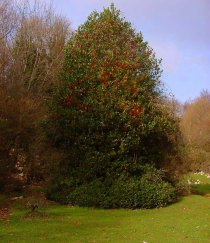The flora of Lucretili Mountains
The current vegetational features on Lucretili Mountains derive from a wavering series of events produced by a human action leading to the change of the original aspects. Vineyards and olive groves characterize these piedmont areas, with skillfully built terracing dating back to Roman times.
The vegetation is formed of large woods (beech, chestnut and hornbeam) and mountain pastures. The flora includes a variety of species, some of which of great ecological importance and rareness. Among them delicate wild orchids and elegant liliaceous plants, holly, storax and the rare Sabine iris (typical of this area).
Till the height of 600 meters, the west and southwest side of the mountain range is characterized by Mediterranean scrub, particularly the high one with holm oaks. In the forest close to Mount Matano or in the area of Mount Le Carbonare are instead present phillyrae: rock rose, mastic tree, myrtle, which vegetate with species that basic-calcareous soils, like terebinth.
Moreover, we must register the presence of Balkan-Eastern species that are a botanic characteristic of the Park: Judas tree, the east hornbeam and especially the styrax. Extremely thick are the formations of mixed oak groves on the slope exposed while in the inner areas, with a more humid and cool climate, prevail the forests with specimen of mountain maple. Beech trees of great size represent the mountain features of the vegetation, like for example in the area of the ancient sheep-track of Cavalera Valley.
On the rise, old grazing lands, we can see strips of mountain meadowlands with botanic species of great interest: the Carlina acaulis and the Iris Sabina. Moreover in all the habitats flower orchids, of which we can register about sixty species.
Surroundings
-
The Sacro Speco

An impressive complex of buildings which almost looks as if it is one with the surrounding rock...
To know more
-
Rocca Pia
Built on the place where Callisto II Borgia's Castle was situated...
-
Church of St.Peter
It was built on the rests of a roman villa...
Tivoli's attractions

Patrocinio Comune di Tivoli
Assessorato al Turismo



